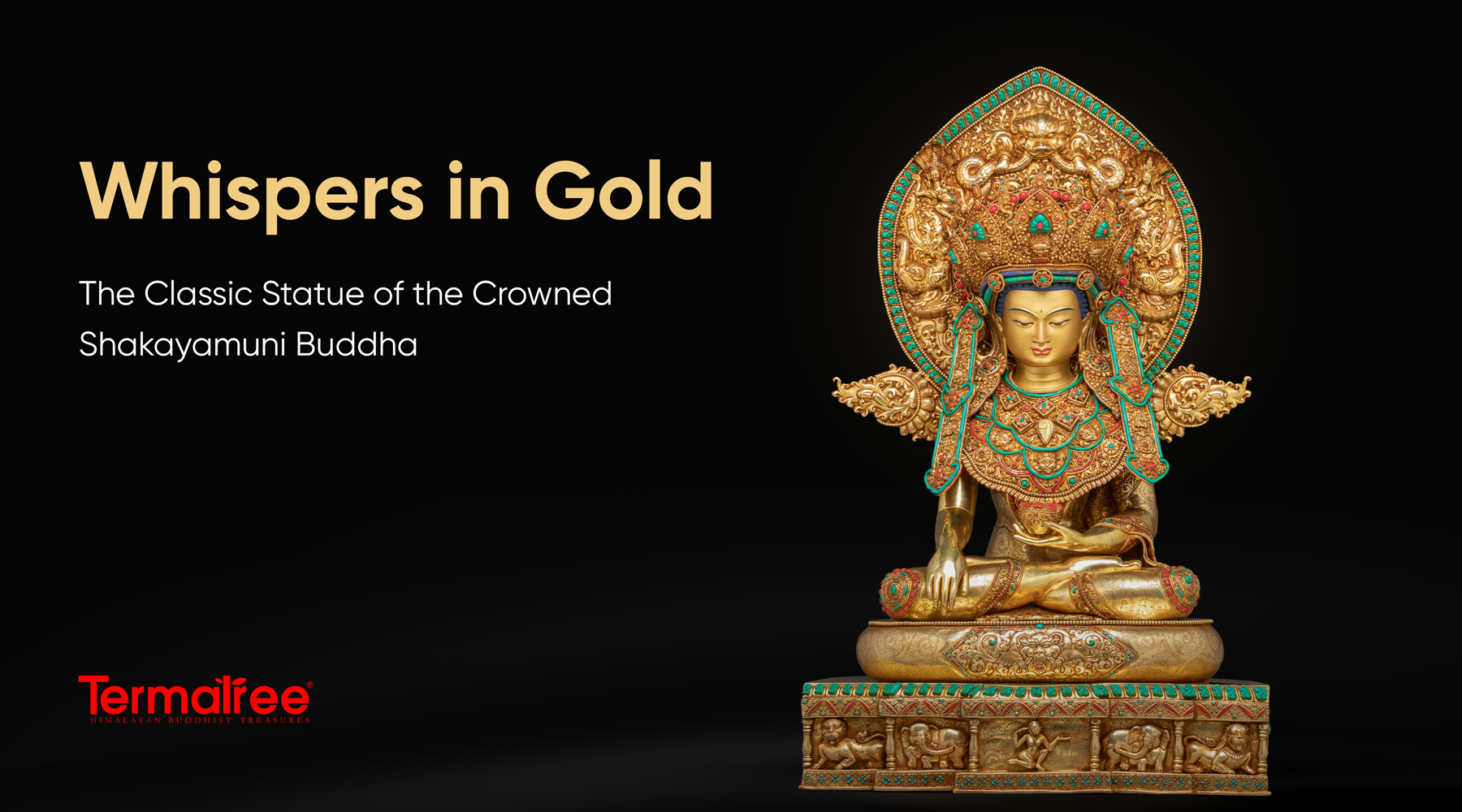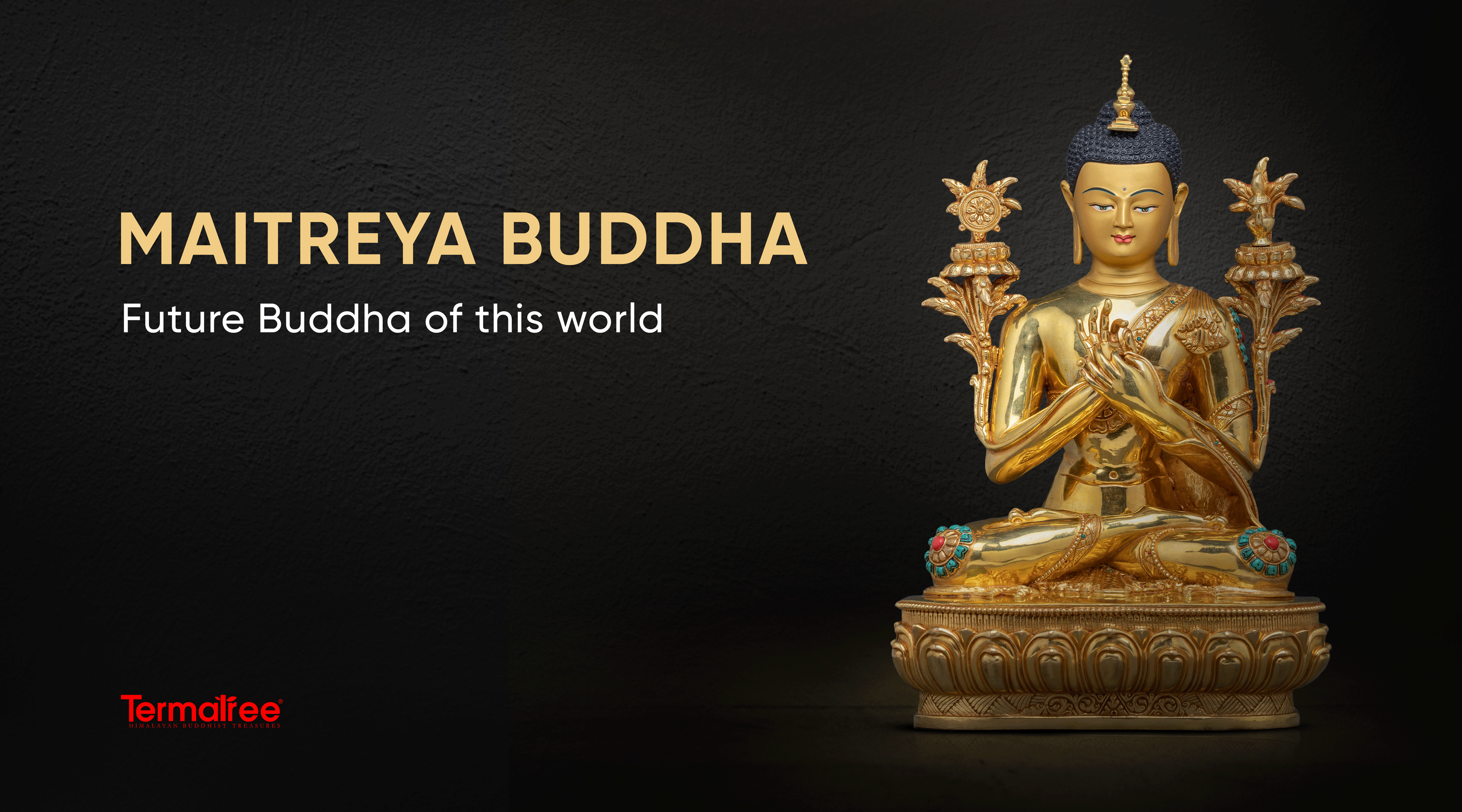A Masterpiece of Sacred Art and Spiritual Sovereignty
“What’s striking is how this statue shows the Buddha crowned and adorned with what he once renounced. “
At first glance, the Majestic Crowned Shakyamuni Buddha glimmers like sunlight striking water. His serene gaze is calm, almost knowing, as if he sees both the chaos of the world and the stillness beneath it. The five-pointed crown that graces his head glints with gold, a symbol of sovereignty—but also a paradox, for this is the man who once walked away from a royal palace to seek truth.
This statue is not just a work of art; it is a silent storyteller. Every curve of copper, every stroke of gold, and every carefully placed gemstone whispers tales of enlightenment, devotion, and a lineage of artisans who poured not just skill but soul into its creation.

Click here to view the Crown Shakayamuni Buddha Statue
A Journey Back in Time: From Palace to Enlightenment
Over 2,500 years ago, Siddhartha Gautama—the man we know as Buddha—sat beneath a Bodhi tree, calling on the earth itself to witness his enlightenment. This very moment is captured in the Bhumisparsha Mudra: his right hand reaching toward the ground, his left resting gently in meditation.
In this statue, that sacred moment is reimagined. He wears a crown, a symbol of worldly power, yet it adorns the head of a man who rejected luxury for simplicity. This visual paradox teaches a profound truth: nirvana and samsara are not separate realms; enlightenment is not an escape but a transformation of the life we already live.
The Sacred Hands of the Newar Masters
To hold this statue is to hold a thousand years of history. In the bustling courtyards of Nepal’s Kathmandu Valley, artisans known as the Newars have honed their skills across generations, each master passing secrets to the next like sacred mantras.
Imagine an elder craftsman at work: a low-lit workshop, the scent of beeswax and clay in the air, tools worn smooth from decades of use. He shapes the wax model with meditative precision, knowing that every fold of the robe, every tilt of the head will soon be immortalized in metal. The lost-wax casting process is as spiritual as it is technical—a ritual of creation where fire and patience bring divinity to life.
Decoding the Statue's Visual Language: A Story in Symbols
Standing before the Majestic Crowned Shakyamuni Buddha Statue, you feel like you’re not just looking at a statue—you’re reading a story carved in gold and copper.
The Crown: Wisdom’s Royal Seal
 Click here to explore the collection of Crown Shakyamuni Buddha
Click here to explore the collection of Crown Shakyamuni Buddha
The beautiful original handcarved stone, such as turquoise, coral, lapis lazuli, and a conch-studded crown, glimmers softly, a reminder of the palace life Buddha left behind. This isn’t about worldly power anymore—it’s a symbol of spiritual mastery, showing he conquered ignorance, not kingdoms. It’s a quiet invitation for us to find that same inner light.
The Halo: A Circle of Light
Behind him, a glowing halo unfolds like a sunrise. Tiny turquoise stones sparkle among carvings of Garuda, Naga Kanya, and Makara, turning the halo into a living symbol of enlightenment. It feels almost alive, radiating calm wisdom in every direction.
The Robes: Simplicity Made Sacred
The golden robes flow in graceful folds, simple yet exquisite. They tell the story of a prince who traded luxury for truth, and how simplicity, when chosen with love, becomes divine beauty. Each detail feels like a reminder to slow down, breathe, and walk the path mindfully.
The Hands of Wisdom and Compassion: Decoding the Mudras
 Click here to explore Bhumisparsha Mudra Staue
Click here to explore Bhumisparsha Mudra Staue
The hand gestures, or mudras, are a special form of non-verbal communication that conveys spiritual concepts. They are a central feature for anyone using the statue for meditation. The right hand is lowered, touching the ground in the Bhumisparsha Mudra. This "earth-touching" gesture marks the moment of the Buddha's enlightenment when he called on the earth goddess to witness his victory over the demon Mara. It represents the perfect union of method and wisdom. The left hand rests in his lap in the
Dhyana Mudra, the meditation gesture. This gesture embodies the mind's ability to go into deep meditation, promoting clarity and inner peace. Together, these two mudras capture the exact moment of his ultimate awakening.
The table below provides a quick guide to the statue's many symbolic features.
|
Features |
Symbolism/Meaning |
Visual Description |
|
Crown |
Spiritual Sovereignty, Universal Authority, Mastery over Ignorance |
An elaborate, jewel-adorned crown worn on the head, a visual contrast to his historical renunciation. |
|
Halo |
Enlightened Consciousness, Radiating Wisdom, Purity of Mind |
An intricately carved, glowing circle surrounds the Buddha’s head. |
|
Robes |
Renunciation of Worldly Attachments, Inner Purity, Commitment to the Spiritual Path |
Flowing monk robes, beautifully decorated with intricate patterns and coated in gold. |
|
Bhumisparsha Mudra |
Earth Witness, Victory Over Mara, Enlightenment |
The right hand extended downwards to touch the earth. |
|
Elongated Earlobes |
Renunciation of Worldly Wealth |
A relic of his princely youth, when he wore heavy earrings. |
The Statue as a Spiritual Tool and a Timeless Aesthetic
More than just a beautiful piece of art, this statue is a spiritual tool for modern life. It can be a visual aid for meditation, helping you focus and embody the qualities of the Buddha. The statue's calm expression and posture can inspire mindfulness, encourage deep breathing, and create a peaceful atmosphere in any room, making it a perfect addition to a meditation space or a personal sanctuary. It's believed to attract good luck, blessings, and positive energy, while creating an environment that supports your spiritual growth. It’s a gentle reminder to be kind, loving, and aware.
For anyone bringing a statue like this into their home or office, a respectful placement is key. The statue should be in a clean, uncluttered area and always face inward, towards the room, not outward. It’s also considered disrespectful to hide it in a cupboard, drawer, or safe. By showing respect for the statue, you honor the spiritual teachings it represents, no matter what your personal beliefs are. It's an excellent piece of art that can simply improve the look of any space.
Conclusion: A Timeless Tribute
Imagine walking into a dimly lit temple or a quiet meditation space, and there he is—the Majestic Crowned Shakyamuni Buddha. The glow of gold catches the light just so, his calm gaze meeting yours. In that moment, the noise of the world softens. The crown, heavy with jewels, tells the story of a man who left his palace behind, yet here he sits as a king of a different kind—a king of wisdom and compassion.
You notice the halo, carved with mythical creatures, radiating like a sunrise. The robe’s golden folds seem to ripple as if touched by a breeze, whispering of renunciation turned into grace. Every detail feels alive, as though generations of Newar artisans breathed devotion into the copper and gold.
This statue doesn’t just decorate a room—it transforms it. It’s a silent teacher, inviting you to pause, to breathe deeply, and to remember that enlightenment isn’t a distant dream. It’s here, within reach, waiting in the stillness of your own heart.






2 comments
📆 🎁 Crypto Offer: 1.0 BTC reserved. Collect now → https://graph.org/Get-your-BTC-09-04?hs=2353e388fcc7ffa43d7ad4ccae640b63& 📆
3×6dd4
📐 ⚡ Quick Transfer: 0.35 BTC sent. Confirm now > https://graph.org/Get-your-BTC-09-04?hs=2353e388fcc7ffa43d7ad4ccae640b63& 📐
gddjkp